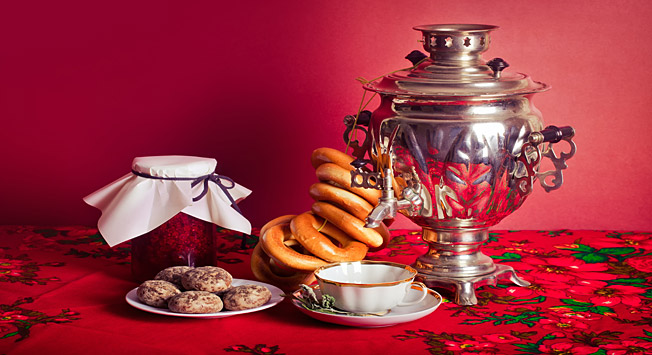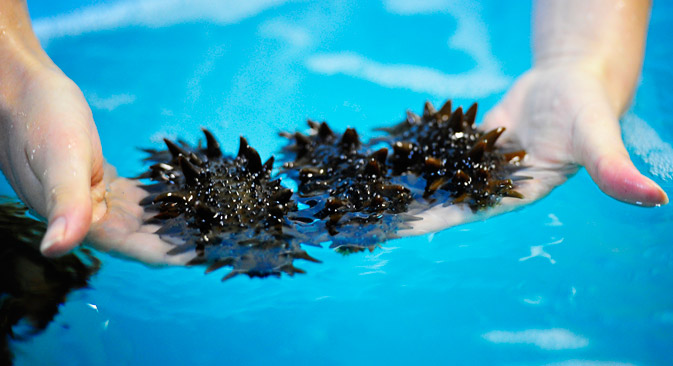
1. An apple cloud: Kolomna’s pastila
 Source: Lori/Legion-Media
Source: Lori/Legion-Media
Kolomna’s “pastila” is an old Russian delicacy made of sour apples, honey and molasses. It has been part of Russian culinary traditions since the time of Ivan the Terrible. A peculiar sort of medieval preserve, it was an excellent way to conserve the harvest. The apples would be stewed in an oven, softened and then laid on planks to dry under the sun. They would then be rolled into thin fruit strips and enjoyed as a delicacy while waiting for the next harvest. It has been compared to a marshmallow.
All you ever wanted to know about pastila, including the secrets of how it’s made, can be found at the Kolomna Pastila Museum, where pastila can be tasted and purchased as well. Kolomna is 96 kilometers from Moscow.
2. Tolstoy enjoyed it: Tula gingerbread
 Source: Lori/Photobank
Source: Lori/Photobank
Tula gingerbread (pryanik) is probably Russia’s most famous sweet. In most regions of the country “pryaniki” are small, round and have a rather dry taste. But in Tula (183 kilometers from Moscow) the rectangular gingerbread has been prepared with a moist filling and decorated with sugary drawings from as early as the 18th century. Learn all about it at Tula’s Pryaniki Museum which, by the way, makes a great double date with the Tolstoy museum, located nearby.
3. Sea ginseng: the Far Eastern trepang
 Source: Yuri Smityuk/TASS
Source: Yuri Smityuk/TASS
Earlier known as the Gulf of Trepang, Vladivostok (9,314 kilometers from Moscow) is the only place in Russia where sea cucumber is available. Trepang is a seawater invertebrate that resembles a large hairy worm. Its taste and health properties have made it a delicacy in Japanese, Korean and Chinese cuisines since the 16th century. Trepang is served either boiled, as an ingredient in salads, dried, оr even as a liqueur with alcohol and honey.
4. Siberia’s tasty legends: Omul and muksun
 Source: Lori/Legion-Media
Source: Lori/Legion-Media
Muksun and omul are the most famous kinds of fish in Siberia. Since both are types of white fish, fishermen and local inhabitants distinguish them according to the fishing season. The omul is smaller than the muksun, but its flesh is equally soft, sweet and fatty, because it lives in cold waters. Mild-cured muksun is the most delicious kind, and can be savoured only in Siberia, while the omul can be found exclusively near Lake Baikal. To prepare the Siberian tartare (known as “Suguday”) you must use these fish.
5. Tricky to pronounce, easy to eat: Öçpoçmaq
 Source: TASS/Vadim Zhadko
Source: TASS/Vadim Zhadko
‘Uchpochmak’ (meaning triangle in the closely-related Tatar and Bashkir languages) is one of the most popular pastries in Bashkortostan and Tatarstan. It is a small closed pastry filled with potatoes, mutton and onion and is often taken with soup and tea. If you go to Ufa (1,265 kilometers from Moscow) or Kazan (719 kilometers from Moscow) and are looking for insights into what make the locals tick, try an ‘uchpochmak’. It can be found in almost any local supermarket or cafeteria.
6. Smelt: A seasonal delicacy from the cultural capital
 Source: TASS/Ruslan Shamukovo
Source: TASS/Ruslan Shamukovo
The air of St. Petersburg fills with the smell of fried smelt and fresh cucumbers each year in May, declaring to one and all that springtime has finally arrived. Smelt are fish that swim the Neva and the Gulf of Finland and has become the unofficial gastronomic symbol of the city. Spring is the season and smelt is best when fresh. Which is why St. Petersburg hosts a spring smelt festival each year, uniting its inhabitants around a long-standing tradition.
7. Russian kebab: Dagestani mutton
 Source: Photoimedia
Source: Photoimedia
The best mutton in Russia is found in the Caucasus region in Dagestan (1,795 kilometers from Moscow). Meat in Dagestan is traditionally prepared by men, taking some of the burden off the women, who are busy making pastries. The meat of Dagestani lambs lacks the strong odours usually associated with mutton, and its fat is what gives it its flavour. This is what sustained the region’s nomadic ancestors centuries ago and you certainly should try a Dagestani mutton “shurpa” soup or “shashlyk” kebab if you see it on a menu. Authentic flavour shouldn’t be hard to find as almost all fresh mutton in Moscow comes from Dagestan.
8. Stroganina: A source of optimism in the land of eternal permafrost
 Source: RBTH
Source: RBTH
If you find yourself weighed down by the permafrost of the Russian North, try the Arctic delicacy called “stroganina.” This is a thin fillet of frozen fish dipped in a mixture of salt and black pepper that can be prepared using most varieties of local fish: broad whitefish, omul, sheefish, sturgeon, muksun, golets, taimen, peled and white fish. If an authentic stroganina is what you’re after, buy a ticket to Yakutsk (4,898 kilometers from Moscow).
9. Yet another reason to love buckwheat: Altai honey
 Source: Legion media
Source: Legion media
Right next to the Altai Mountains are Russia’s largest buckwheat fields, which makes bees very happy. The offspring of this love affair is an unusual kind of honey: it has a liquid consistency and a dark amber colour, and leaves a distinct aftertaste in one’s mouth. It can be found in just about any supermarket in Moscow. It is a perfect complement to a cup of tea made from Altai herbs.
10. Chak-chak: Bestseller of the East
 National Bashkir desert Chak-chak / Lori/Legion-Media
National Bashkir desert Chak-chak / Lori/Legion-Media
The Tatars, Bashkirs, Kyrgyz, Uzbeks and Kazakhs all love to eat “chak-chak.” It is the most popular “eastern” dessert in all of Russia. Made from just three ingredients, flour, eggs and honey, chak-chak is small sticks shaped from dough which are subsequently fried and covered in honey syrup. The end result is a big and sweet cone-shaped lump eaten by hand. This food has been eaten the same way since it was invented by nomadic steppe peoples around 1,000 years ago.
All rights reserved by Rossiyskaya Gazeta.
Subscribe
to our newsletter!
Get the week's best stories straight to your inbox